Entry #1 - Implications of A.I. in Education
- victorsweeney3
- Feb 25, 2023
- 3 min read
Updated: Mar 20, 2023
"Freedom - No limitations on what you can enter" (Stable Diffusion)
Artificial Intelligence (A.I.) permeates a great deal of our daily lives, especially through online technologies such as social media and advertising algorithms. Recently however, A.I. tools continue to develop in unique avenues in the advent of A.I. image generation, whose implications in our broader cultures and societies continue to be redefined. This trajectory would inevitably intersect with education, specifically, in how it may support, improve, or potentially limit fostering creativity (McCormack, & d’Inverno, M. n.d.).
How Can A.I. be Used to Foster Creativity in the Classroom?
A.I. Art
Using text prompts, A.I. art generators like Dall-E 2 and Stable Diffusion are able to produce unique images that visualise your description. As demonstrated in Figures 2 and 3.

There are a plethora of creative opportunities offered by A.I. art in the classroom, particularly in its ability to act as an effective prompting tool for activities in creative writing or storyboarding. For example, the third image of Figure 2 that I generated effectively establishes a clear dramatic tone and atmospheric context, whose inherent ambiguity allows for substantial divergent thinking and creative diversity on how students can design their own narrative (Ali & Parikh, 2021). Furthermore, the reverse engineering of a generated image could be an engaging activity in applying abstract thinking by having students collaborate and unravel the prompts of an image.

From a teaching perspective, the use of A.I. art holds several notable limitations. Namely, its potential for limiting creativity amongst students, and that the inherent ambiguity of image generation creates unclear expectations for graded assessment (Wilson & Brown, 2015, p. 146). For example, the fourth image that I generated in Figure 3 using the prompt "Future Humans" is meant to be a comic strip, however, the speech bubbles and scene itself are unclear, thus, little information can be gained. Therefore, this image would be a poor example to use as an image prompt.
A.I. & Pedagogy
The core issue for A.I. technology relates to the lack of an appropriate ontological and epistemological language to articulate creative quality (Leonard, 2021, p. 31); particularly, as this translates to curricular outcomes and assessments. However, as a step “beyond instrumentalism” (Knochel et al., 2020, p. 2), one could argue the pedagogical implications of A.I. in fostering creativity centres around an "informed knowledge of possibilities", particularly at a Stage 6 level (NESA, 2016). In promoting the understanding of visual meaning, students are able to address and challenge preconceived constructs of the limits of creativity and cognition (Nicholas Leonard. 2021). Therefore, assessing the use of A.I. Art generations should focus on students’ abstract thinking and understanding of novel possibilities, as well as, teaching for creativity that enables exploring "more new possibilities" (Lin. 2011, p. 152).
Links
https://openai.com/product/dall-e-2 (Accessed on 25 Feb)
https://stablediffusionweb.com/ (Accessed on 25 Feb)
References
Ali, S., & Parikh, D. (2021). Telling creative stories using generative visual aids. arXiv preprint arXiv:2110.14810.
Knochel, A. D., Liao, C., & Patton, R. M. (Eds.). (2020). Critical digital making in art education. New York, NY: Peter Lang Publishing.
Koh, Chai, C. S., Wong, B., & Hong, H.-Y. (2015). Design Thinking for Education Conceptions and Applications in Teaching and Learning. Springer Singapore. https://doi.org/10.1007/978-981-287-444-3
Leonard, N. (2021). EMERGING ARTIFICIAL INTELLIGENCE, ART AND PEDAGOGY: EXPLORING DISCUSSIONS OF CREATIVE ALGORITHMS AND MACHINES FOR ART EDUCATION. Digital Culture & Education, 13(1), 20–41.
Lieberman, M. (2020). How Educators Can Use Artificial Intelligence as a Teaching Tool. EducationWeek. Available at: https://www.edweek.org/teaching-learning/how-educators-can-use-artificial-intelligence-as-a-teaching-tool/2020/05
Lin. (2011). Fostering Creativity through Education – A Conceptual Framework of Creative Pedagogy. Creative Education, 2(3), 149–155. https://doi.org/10.4236/ce.2011.23021
McCormack, & d’Inverno, M. (n.d.). Computers and Creativity: The Road Ahead. In Computers and Creativity (pp. 421–424). Springer Berlin Heidelberg. https://doi.org/10.1007/978-3-642-31727-9_16
NSW Education Standards Authority (2016) Visual Arts: Stage 6 Syllabus. https://educationstandards.nsw.edu.au/wps/portal/nesa/11-12/stage-6-learning-areas/stage-6-creative-arts/visual-arts-syllabus
WILSON, C., & BROWN, M. (2015) AMBIGUITY, UNCERTAINTY AND NEW REALITIES: PERSPECTIVES OF CREATIVE VALUE, UTILITY AND AUTHENTICITY. KIE handbook of, 134. Chicago
Neural Synesthesia (2022). Voyage through Time - A Generative A.I. Journey. Available at: https://www.youtube.com/watch?v=Bo3VZCjDhGI










Hi Victor,
I found your blog very interesting and I enjoyed reading it. I found it very clear to read and the content was very well organised. Your introduction did a great job of setting the context of AI and I think gave a good platform for the rest of your article. The ideas around how each particular form of AI could be used in the classroom was very helpful and gave me lots of ideas for my future practice. I think your post raises good questions about how to effectively embed A.I into school practices in order to enhance creativity.